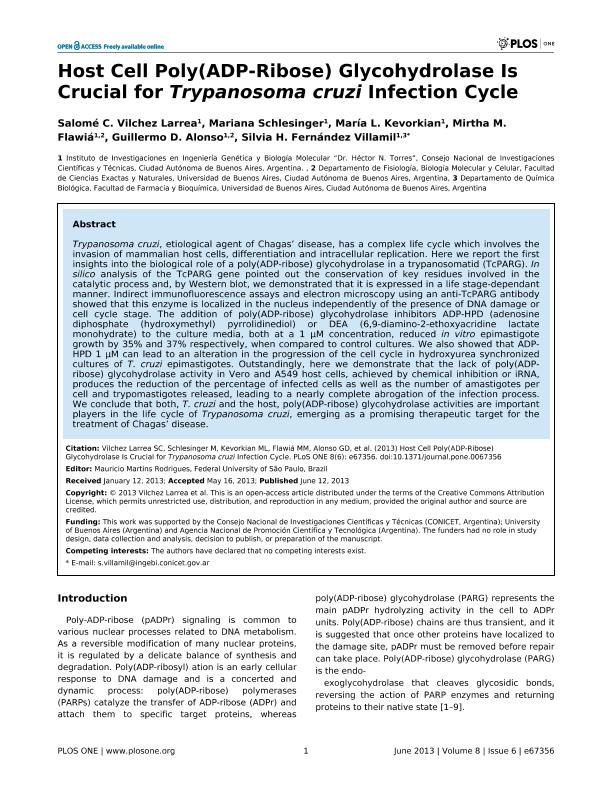Mostrar el registro sencillo del ítem
dc.contributor.author
Vilchez Larrea, Salomé Catalina

dc.contributor.author
Schlesinger, Mariana

dc.contributor.author
Kevorkian, María Laura

dc.contributor.author
Flawia, Mirtha Maria

dc.contributor.author
Alonso, Guillermo Daniel

dc.contributor.author
Fernandez Villamil, Silvia Hebe

dc.date.available
2015-07-20T17:11:40Z
dc.date.issued
2013-06-12
dc.identifier.citation
Vilchez Larrea, Salomé Catalina; Schlesinger, Mariana; Kevorkian, María Laura; Flawia, Mirtha Maria; Alonso, Guillermo Daniel; et al.; Host Cell Poly(ADP-ribose) glycohydrolase Is Crucial for Trypanosoma cruzi Infection Cycle; Public Library Science; Plos One; 8; 6; 12-6-2013; e67356-e67356
dc.identifier.issn
1932-6203
dc.identifier.uri
http://hdl.handle.net/11336/1277
dc.description.abstract
Trypanosoma cruzi, etiological agent of Chagas´ disease, has a complex life cycle which involves the invasion of mammalian host cells, differentiation and intracellular replication. Here we report the first insights into the biological role of a poly(ADPribose) glycohydrolase in a trypanosomatid (TcPARG). In silico analysis of the TcPARG gene pointed out the conservation of key residues involved in the catalytic process and, by Western blot, we demonstrated that it is expressed in a life stagedependant manner. Indirect immunofluorescense assays and electron microscopy using an anti-TcPARG antibody showed that this enzyme is localized in the nucleus independently of the presence of DNA damage or cell cycle stage. The addition of poly(ADP-ribose) glycohydrolase inhibitors ADP-HPD (adenosine diphosphate (hydroxymethyl)pyrrolidinediol) or DEA (6,9-diamino-2-ethoxyacridine lactate monohydrate) to the culture media, both at a 1 μM concentration, reduced in vitro epimastigote growth by 35% and 37% respectively, when compared to control cultures. We also showed that ADP-HPD 1 μM can lead to an alteration in the progression of the cell cycle in hydroxyurea synchronized cultures of T. cruzi epimastigotes. Outstandingly, here we demonstrate that the lack of poly(ADP-ribose) glycohydrolase activity in Vero and A549 host cells, achieved by chemical inhibition or iRNA, produces the reduction of the percentage of infected cells as well as the number of amastigotes per cell and trypomastigotes released, leading to a nearly complete abrogation of the infection process. We conclude that both, T. cruzi and the host, poly(ADP-ribose) glycohydrolase activities are important players in the life cycle of Trypanosoma cruzi, emerging as a promising therapeutic target for the treatment of Chagas´ disease.
dc.format
application/pdf
dc.language.iso
eng
dc.publisher
Public Library Science

dc.rights
info:eu-repo/semantics/openAccess
dc.rights.uri
https://creativecommons.org/licenses/by/2.5/ar/
dc.subject
Poly(Adp-Ribose)Glycohydrolase
dc.subject
Trypanosoma Cruzi
dc.subject
Cell Infection
dc.subject
Parg Inhibitors
dc.subject.classification
Bioquímica y Biología Molecular

dc.subject.classification
Ciencias Biológicas

dc.subject.classification
CIENCIAS NATURALES Y EXACTAS

dc.title
Host Cell Poly(ADP-ribose) glycohydrolase Is Crucial for Trypanosoma cruzi Infection Cycle
dc.type
info:eu-repo/semantics/article

dc.type
info:eu-repo/semantics/publishedVersion

dc.type
info:ar-repo/semantics/artículo
dc.date.updated
2016-03-30 10:35:44.97925-03
dc.journal.volume
8
dc.journal.number
6
dc.journal.pagination
e67356-e67356
dc.journal.pais
Estados Unidos

dc.journal.ciudad
San Francisco
dc.description.fil
Fil: Vilchez Larrea, Salomé Catalina. Consejo Nacional de Investigaciones Científicas y Técnicas. Instituto de Investigaciones en Ingeniería Genética y Biología Molecular; Argentina
dc.description.fil
Fil: Schlesinger, Mariana. Consejo Nacional de Investigaciones Científicas y Técnicas. Instituto de Investigaciones en Ingeniería Genética y Biología Molecular; Argentina
dc.description.fil
Fil: Kevorkian, María Laura. Consejo Nacional de Investigaciones Científicas y Técnicas. Instituto de Investigaciones en Ingeniería Genética y Biología Molecular; Argentina
dc.description.fil
Fil: Flawia, Mirtha Maria. Consejo Nacional de Investigaciones Científicas y Técnicas. Instituto de Investigaciones en Ingeniería Genética y Biología Molecular; Argentina. Universidad de Buenos Aires. Facultad de Ciencias Exactas y Naturales. Departamento de Fisiología, Biología Molecular y Celular; Argentina
dc.description.fil
Fil: Alonso, Guillermo Daniel. Consejo Nacional de Investigaciones Científicas y Técnicas. Instituto de Investigaciones en Ingeniería Genética y Biología Molecular; Argentina. Universidad de Buenos Aires. Facultad de Ciencias Exactas y Naturales. Departamento de Fisiología, Biología Molecular y Celular; Argentina
dc.description.fil
Fil: Fernandez Villamil, Silvia Hebe. Consejo Nacional de Investigaciones Científicas y Técnicas. Instituto de Investigaciones en Ingeniería Genética y Biología Molecular; Argentina. Universidad de Buenos Aires. Facultad de Farmacia y Bioquímica. Departamento de Química Biológica; Argentina
dc.journal.title
Plos One

dc.relation.alternativeid
info:eu-repo/semantics/altIdentifier/doi/http://dx.doi.org/10.1371/journal.pone.0067356
dc.relation.alternativeid
info:eu-repo/semantics/altIdentifier/url/http://journals.plos.org/plosone/article?id=10.1371/journal.pone.0067356
Archivos asociados
